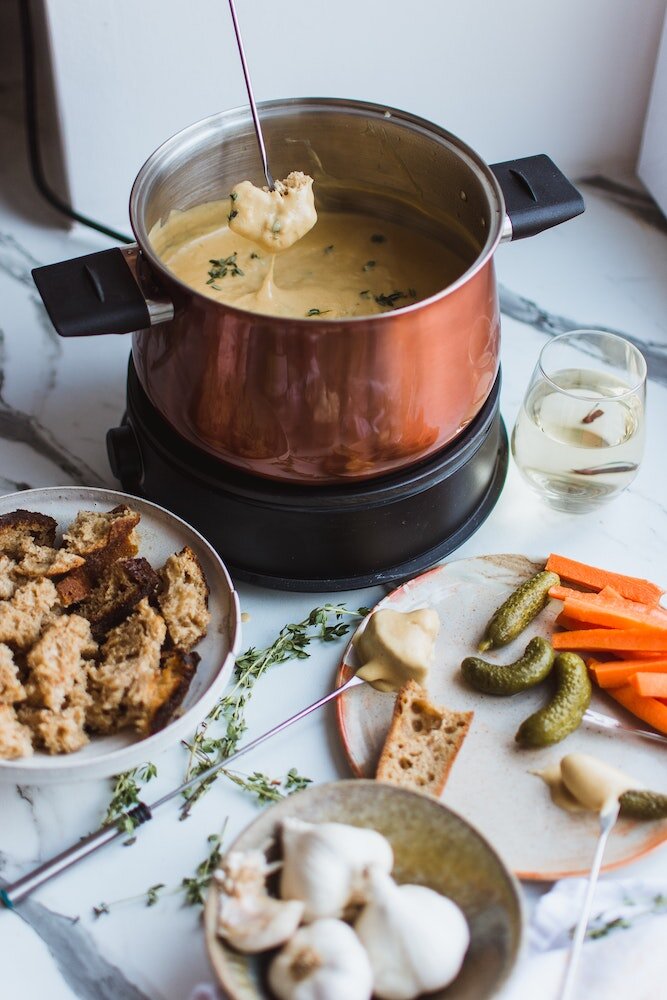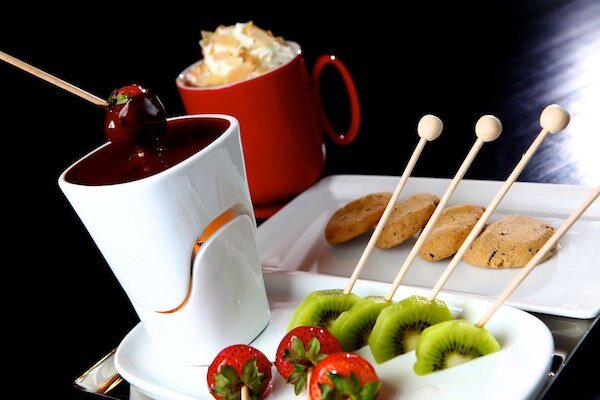Bringing Back Fondue
Photo by Klara Avsenik on Unsplash
Ours is not, I know, the only home with a fondue pot exiled to the back of a rarely opened cupboard. We purchased ours just over a decade ago on an Ikea buying binge to furnish a new house, our first rental in the San Francisco Bay Area.
For both of us, children of the 1970s, fondue resonates. For me, it conjures up remembrances of family ski trips past, when the simple hot-cheese dish capped off a day on the slopes. Fondue left its mark on me literally: I still have a small scar on my left palm where I pushed one of those special, sharp-tined fondue forks right through the bread and into my hand. For my husband David, the dish reminds him of his crew of bright, quirky high-school friends, who, rather than attend some big dance, held a fondue party, gorging on cheese, meat and chocolate fondues until they near passed out. Fondue became part of their collective schtick, and this group still serves various fondues most New Year's Eves, back in our native Canada. With the border to our home country currently closed, we brought the pot out for a few evenings, hoping it would remind us of auld acquaintance we can't currently see and conjure up better, less isolated times. If only a dish could really do that.
In our kitchen, we started with the classic Moitié-Moitié version, following recipes in the canonical texts, as well as an excellent one used by San Francisco chef Nathalie Horwath. Then we tried some more adventurous takes, including, one with bourbon, Belgian beer and Babybel cheese in the mix – our sole disaster, an oily mess. Juliana Uruburu, expert cheesemonger and retail director at Oakland's Market Hall, doesn't blame us for this failure, saying we were fighting science. “Alpine cheeses work well as a basis for fondue,” she says, “because they have lower proportion of fat than Edam cheeses, like Babybel, do. They tend to melt into something smooth, with no oil gathering at the pan edges.” For our subsequent fondues, she proposes Swiss classics like Gruyère, Appenzeller and Chällerhocker, French cheeses like chalky Comté, and creamy Vacherin Fribourgeois, made in both countries. She also puts one Californian cheese, San Geronimo from Nicasio Valley Cheese, in our basket. Nicasio Valley Cheese has a deep connection to Switzerland, it was founded by the Lafranchi family who came to California from Switzerland and make some Swiss style cheeses.
Photo credit Alma Avalos
Cheese is a calling for her. Uruburu remembers her father picking her up when she was a girl and putting her on the counter at Berkeley Cheeseboard Collective, where the staff would give her a chunk of Canadian cheddar to gnaw on, while her father shopped. Pre-COVID, fondue was something Uruburu often did for staff parties, and, with no such parties to host, she loans us some of her gear, more authentic than our Ikea-sourced pot, to experiment further. One of her devices to keep the fondue warm on the table frames a little sterno brazier in a wrought-iron surround featuring cows with crowns of flowers on them. “The Swiss farmers send the cows up to the mountain meadows,” says Alma Avalos, Uruburu's right-hand woman at the Cheese Counter. “When the cows come back down the mountains in the fall, villagers put flowers on them to thank them, since much of the local economy depends on them.” She shows me photos she's snapped of garlanded cows on Swiss mountainsides.
Fondue has some pedigree in Europe, with a primitive version made of melted goat cheese mentioned in the Iliad. The Swiss have their own legends about its origins. By one account, it was a dish that sealed a truce between the ever-warring Catholics and Protestants, one side bringing the bread, the other the melted cheese. By another, it originated as a peasant dish, with cowherds resuscitating stale bread with cheese made molten over mountain-side fires.
“These are fairytales, of course,” says Isabel Raboud-Schüle, reached over Zoom. She is an ethnologist, by training, who directs the Gruyère Museum, a municipal institution in the Swiss town that gave the common fondue cheese its name. “Fondue was never a peasant dish. These cheeses were always expensive to make, and so fondue was mainly prepared for the merchants in towns, the bourgeois, who were already exporting the cheese to markets in Italy, France and Germany in the 18th century.” The first modern recipe for fondue, with the cow cheeses we now tend to use, comes out of Zurich, she says, in 1699, and then the famous French cookery writer, Jean Anthelme Brillat-Savarin, spread word of the dish further, in his influential 1825 text, Physiologie du Goût. “But his was really a scrambled egg and cheese dish, not the one we now think of as fondue. Again, cheese was expensive, so the use of eggs may have helped in the binding of the dish and reduced the cost.” By the time, the always definitive Madame E. Saint-Ange came to publish her French cooking bible, La Bonne Cuisine, in the 1920s, the eggs had been chucked.
For years, French and Swiss cheesemakers have bickered over which country gets the bragging rights to creating the dish, but that's not a debate Raboud-Schüle wants to wade into. “It's not something that you can say, 'Oh, this person in this year thought of making this dish,'” she says, adding, diplomatically, “So far as we can tell the area of the Alps where people speak French is where it comes from.” What she will say is that it was the Swiss, in the 20th century, who chose to wrap their national identity up with fondue and who are chiefly responsible for making it go global. “In the 1930s, the warming pots, which are called caquelons, an old French word for 'pot', were distributed along with recipes to the entire Swiss Army – and since all Swiss men needed to serve some time annually, it spread the dish to regions where it hadn't formerly been a specialty.” After WWII, the powerful Swiss Cheese Union helped push the dish into international markets, running ad campaigns around the world of healthy Swiss people, often in après-ski gear, eating fondue in picturesque mountainside chalets.
"Chocolate Fondue" by SofitelSoBangkok is licensed under CC BY-NC-ND 2.0
Born and bred in Switzerland, Caroline Hostettler has been importing Swiss cheeses to the US since 1997 through her firm Quality Cheese, and says fondue blew up as a dish in the US for several reasons. “More Americans were traveling then and wanted to bring back the dishes they met up with abroad, and skiing was getting more popular, too, so it became the key aprés-ski dish.” She also cites the quaint Alpine restaurants serving the dish at the two New York World's Fairs, in 1939 and 1964, as well as the restaurant, Chalet Suisse, run by Swiss Chef Konrad Egli at the base of the mid-town Manhattan building housing various Swiss multinationals. (Egli is the man who invented the chocolate fondue as a promo for Toblerone.)
“I started this business,” says Hostettler, a former food writer, “because I was standing in line at an American deli, and a woman ordered slices of something she called Munster, this big orange block. I thought they should have better cheeses.” Many American recipes for fondue use Emmenthaler, a cheese this self-described purist would never put in her own fondues – “It gets stringy when melted. It's just what was available here for so long.”
"Eindhoven's Retro Fondue Restaurant" by Inhabitat is licensed under CC BY-NC-ND 2.0
In an effort to keep traditional cheesemaking alive, Hostettler created a program called Adopt-an-Alp, which allows cheese shops (like the one at Market Hall) to follow the creation of the cheese, to watch the cows heading up to their Alpine meadows in the summer, see the cheeses getting started in small huts in the mountains, and follow the various moves towards completion. “On our site, you can see the cows with their flower-crowns coming down the mountains,” she says.
Although the dish is a social one, she says she's heard of many others making fondue during the shutdown, for the same reasons we have – to conjure up better times. “In general, in the last couple of years, fondue has had something of a renaissance. People saying, oh, I have this pot from when I got married. Shouldn't I use it? It's not the days when fondue was fab in the 1970s and '80s, but there's been an uptick.” When Uruburu loans us her fondue gear, her assorted steel and ceramic caquelons, her collection of many long, pronged forks, she sighs, “I can't wait for our first fondue party after this.”





